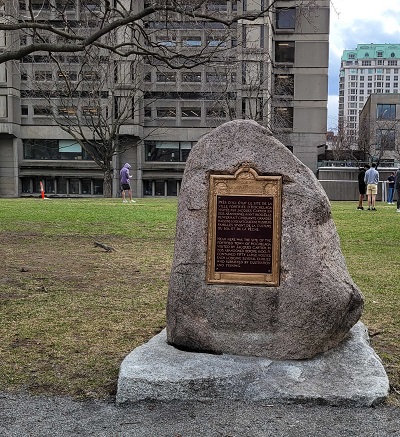Hochelaga National Historic Site of Canada
Montréal, Quebec

Plaque location
© Parks Canada | Parcs Canada
Address :
845 Sherbrooke Street West, Main entrance of McGill University, Montréal, Quebec
Recognition Statute:
Historic Sites and Monuments Act (R.S.C., 1985, c. H-4)
Designation Date:
1920-01-30
Dates:
-
1535 to 1535
(Significant)
Event, Person, Organization:
-
Jacques Cartier
(Person)
-
the Iroquois
(Organization)
Other Name(s):
-
Hochelaga
(Designation Name)
Research Report Number:
2007-CED-SDC-008
Plaque(s)
Existing plaque: on a boulder at the Main Gates of McGill University 845 Sherbrooke Street West, Montréal, Quebec
Near here was the site of the fortified town of Hochelaga visited by Jacques Cartier, in 1535, abandoned before 1600. It contained fifty large houses, each lodging several families who subsisted by cultivation and fishing.
*À noter : Cette désignation fera l’objet d’une revue. Une revue a lieu pour l’une des raisons suivantes : formulation ou termes désuets, absence d’un aspect important de l’histoire, erreurs factuelles, croyances et comportements controversés ou acquisition de nouvelles connaissances.
Description of Historic Place
Hochelaga National Historic Site of Canada is a cultural landscape recalling a former Iroquois village, consisting of a grass-covered space about 79 square metres in area. The site is located to the left of the main entrance of McGill University on Sherbrooke Street, Montreal. The official recognition applies to the area within a radius of 5 metres around a stone, which was laid in 1925 and on which the plaque is mounted.
Heritage Value
Hochelaga was designated a national historic site of Canada in 1920. It is designated for the following reason: it is the Iroquois village of Hochelaga that was visited by Jacques Cartier in 1535 and abandoned before 1600.
Hochelaga National Historic Site of Canada represents the old Iroquois village of Hochelaga. The village is mentioned in the logbook kept by Jacques Cartier on his second voyage to the region of the St. Lawrence River in 1535. The village no longer exists, and its exact location is unknown.
The historical value of Hochelaga National Historic Site of Canada derives from its association with the Iroquois village of Hochelaga. According to Cartier’s log for October 1535, the palisaded village was home to about 1500 Iroquois living in some 50 longhouses approximately 8 metres high and of varying lengths, with groups organized according to maternal family ties. A subsequent French expedition in 1600 noted that the village of Hochelaga was abandoned. This coincided with the departure of all the Iroquois from the St. Lawrence Valley after they were excluded from new trading alliances between the French and the Montagnais, Algonquin and Huron nations. To consolidate their fur trade relations, the French became hostile toward the Iroquois, resulting in their departure.
Sources: Historic Sites and Monuments Board of Canada, Minutes, 2007; Report to the Status of Designations Committee, 2007.
Character-Defining Elements
The heritage character of Hochelaga National Historic Site of Canada derives from: the location of the cairn used to represent the former Iroquois village; the scenic views from the site; the integrity of potential archaeological resources, objects and sites.